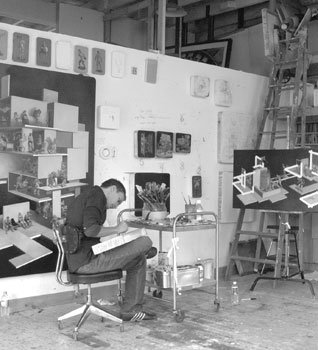Erik Sandberg
dal 18/11/2004 al 23/12/2004
Segnalato da
18/11/2004
Erik Sandberg
Conner Contemporary Art, Washington
Painting. ''Sandberg's medium is coexistent with his subject for, to him, painting is the rendering of the human figure and the human figure is rendered best in oils. His figures act as automatons, alternately driven by compulsions of the flesh or overcome by the inertia of physical matter.'' Jamie L. Smith.

In the Flesh: the Paintings of Erik Sandberg
by Jamie L. Smith
“Would to God...that I could see the work and art of the mighty masters to come, who are yet unborn...Often in my sleep do I behold great works of art...but so soon as I awake my memory loses hold of [them],†wrote Albrecht Dürer. If we presume to imagine the German Renaissance genius’s response had his dreams been visited by future photographic media, we might wonder whether that precocious realist, who declined painting commissions to pursue engraving technology, would have asked a question now often voiced: Given new technologies of image replication, why do artists continue to create naturalistic imagery with oil paint? Compelling answers resound in the works of Erik Sandberg, who reckons with the early modern origins of naturalism to emblazon his identity as a contemporary painter.
Sandberg’s medium is coexistent with his subject for, to him, painting is the rendering of the human figure and the human figure is rendered best in oils. The conceptual bond between oil paint and human form finds precedent in writings of the 16th-century Flemish painter, Karel van Mander, who, in the first history of Northern European art, allegorized the relation of lifeless, monochromatic underpaintings to quickening, colorful oil glazes applied over them as the body’s relation to the soulii. Sandberg preserves the additive method of glazing colors over preliminary monochromatic paintings, but inverts, or, one might say, perverts the body-soul allegory. Beneath the grotesque veneer of each of his finished figures lies a previous incarnation that once looked ethereal and full of light. These nascent images, wrought in warm undertones delicately heightened with white, initially possessed a crystalline visual purity cognate to the tabula rasa of the human soul. It is humanity’s fall from grace, however, that Sandberg thematizes in the latter phases of his craft. Through a ponderous ritual he systematically debases his newly formed beings cladding them with progressively more colorful and unforgivingly descriptive iniquities of the flesh. Applying layers of successively thicker, oilier, and fleshier-pigmented paint Sandberg materially actualizes the carnality of his figures while informing their moral dispositions by situating them in compromising circumstances and animating them with unseemly actions.
Sandberg’s imagery reveals that his imagination runs wild, though its seamless representational style testifies that his brush does not. He eschews both the raw corpulence of Willem DeKooning’s women and the clotted gore of Philip Guston’s appendages to uphold the Renaissance dictum that true art conceals itselfiii. Sublimating painterly gesture Sandberg avows human flesh rather than paint is the very stuff he would shape. The artist reinforces this conceit emphasizing the body’s vulnerable plasticity in visceral themes such as: body image in Alterations, where an obese figure confronts an average-build cookie cutter template; vanity in House Interior where an old woman irons her wrinkled breasts; and mortality in Place where patients submit to medical butchery. Sandberg recalls his stylistic origins depicting correctional implements from the era when oils became the preeminent medium of naturalism, like the shackles suspending a woman by her feet in Fill 2. He exploits the structures of antique torture devices to fashion images of the human form in a wide variety of unnatural poses, thereby reformulating the Northern Renaissance tenet that the precise description of copious varieties of natural form defines artistic skilliv. Thus Sandberg creates an extensive store of figural permutations which functions in his canon as a measure of his artistic invention.
The artist deploys these figures as characters in incisive narratives that cut to the core of our being. Sandberg’s figures act as automatons, alternately driven by compulsions of the flesh or overcome by the inertia of physical matter. To these personae he ascribes sentient qualities, but signals in their vacant facial expressions they are not fully self-possessed. As viewers we are quick to assure ourselves we possess the divine spark they lack, lest we acknowledge that their extreme behaviors stem from traits of passivity and physical compulsion inherent to human nature. The extent to which Sandberg identifies with the fleshly imperfections of his creatures is evident in Inventory 3 where he depicts himself devouring a chunk he carved out of his thigh. Be they male, female, active or passive, all of his figures portray components of the same mortal psyche. As the artist explains, “They’re all me.†Though the practice of self-portraiture originated with the Northern masters, it is difficult to reconcile Sandberg’s demoralized self-imaging with Dürer’s Christ-like self-portraitsv. So accurately did they reflect their creators and the world in which they lived, that early oil paintings were often described as mirrorsvi. Sandberg’s abhorrent imagery calls attention to profound differences between the culture of his predecessors and our own. The founders of the oil technique referred to themselves as schilders, a Dutch term derived from the word for shield, cleaving to devotional concepts of the faithful anointing their shields with oil and crusader knights arming themselves with shields painted in Christ’s bloodvii. Neither piety nor chivalry shines forth from Sandberg’s paintings, yet they do participate in a form of heraldry, because in them he fashions a new coat of arms bearing the insignia of human vulnerability. More than a few of us may recognize our mortal lineage as we contemplate the shield of one who battles so fiercely with his own carnal nature.
Jamie L. Smith, A.B.D.
Assistant Professorial Lecturer
The George Washington University
opening reception:
Saturday, November 20th: 6-8 pm
artist in attendance
H: Tuesday - Saturday: 11am-6pm.
catalogue available.
Conner Contemporary Art
1730 Connecticut Avenue, NW - 2nd Floor
Washington, DC 20009



